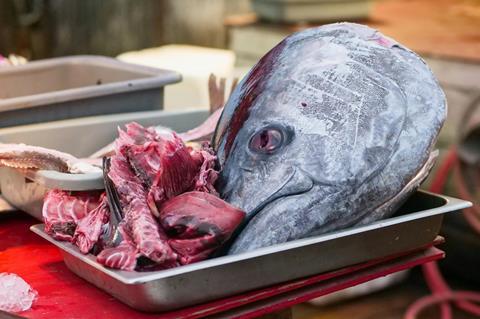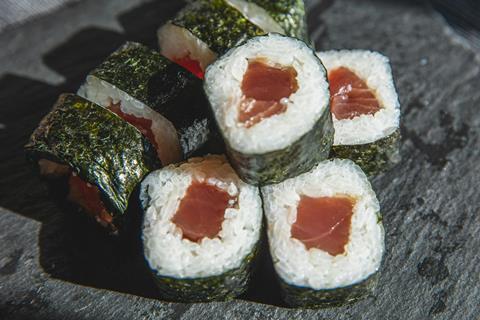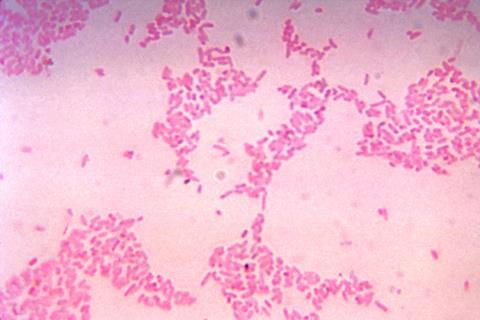An engineered gut microbe can detoxify methylmercury, reducing the amount that passes into the brain and developing fetuses of mice fed a diet rich in fish, UCLA and UC San Diego’s Scripps Institution of Oceanography scientists have discovered.

UCLA and UCSD scientists inserted DNA-encoding methylmercury detoxification enzymes into the genome of an abundant human gut bacterium. The engineered bacterium detoxified methylmercury in the gut of mice and dramatically reduced the amount that reached other tissues, such as the brain and liver.
READ MORE: Study reveals how microbes create the most toxic form of mercury
READ MORE: Probiotic could help mitigate mercury absorption in the gut
Mice given an oral probiotic containing the engineered microbe and fed a diet high in bluefin tuna had much lower methylmercury levels than expected, suggesting that a probiotic might eventually make it safer for people to consume fish.
Researchers performed the tests using pregnant mice and found lower levels of methylmercury in both maternal and fetal tissues, and lower signs of mercury toxicity in the fetal brain.
Probiotics for pregnancy
“We envision the possibility that people could take a probiotic to offset the risk of consuming too much methylmercury, especially when pregnant,” said UCLA associate professor and director of the UCLA Goodman-Luskin Microbiome Center Elaine Hsiao, who is the senior author of a paper describing the research in the journal Cell Host & Microbe.
Mercury is a pollutant that enters water from several sources, the largest of which are human activities such as coal burning, artisanal gold mining and smelting, and wastes from consumer products. In the ocean, mercury transforms into a toxic form called methylmercury. It also biomagnifies, meaning that methylmercury concentrations in animal tissues increase up the food chain from algae-eaters to top predators like humans.

This means that all the methylmercury in something an organism eats goes into its tissues and is passed on to whatever eats it. Organisms near the top of their food chains, like bluefin tuna and humans, acquire all the mercury accumulated by the previous links in the chain. Thus, people who primarily eat food containing high mercury levels are at higher risk of mercury poisoning and birth defects.
Methylmercury threat
“Despite global efforts to reduce mercury emissions and its accumulation in fish, methylmercury levels in seafood are not expected to decline anytime soon. Fish remains a major and culturally important part of the diet for many people around the world and we hope it continues to be,” said co-senior author and Scripps associate professor of marine biogeochemistry Amina Schartup.

Researchers modified Bacteroides thetaiotaomicron, a naturally abundant bacterium in the human digestive tract, by inserting DNA-encoding mercury detoxification enzymes from a mercury-resistant soil bacterium. After confirming that the engineered bacteria could clear methylmercury in a test tube, they replaced the natural gut microbiomes of mice with the modified bacteria and orally administered a large amount of methylmercury all at once. The mice had lower levels of methylmercury in their intestines just three hours after, and the level continued to fall for four days, showing that the bacteria helped to effectively eliminate the methylmercury in the intestine.
Tissue levels
They next asked whether the engineered bacteria would be effective at decreasing tissue methylmercury levels when exposure occurs gradually through routine dietary intake. To test this, the researchers fed the mice diets containing bluefin tuna over a period of days and found that not only did the bacteria reduce mercury in the intestine just as well, but less entered the brain and liver, too.
They then tested pregnant mice and found lower levels of methylmercury in both maternal and fetal tissues, and lower signs of mercury toxicity in the fetal brain.
“By reducing dietary methylmercury in the intestine, the gut bacteria helped to eliminate it from the body before it could enter the maternal bloodstream and access the developing offspring,” said first author and UCLA research scientist Kristie Yu.
Biologically meaningful
Co-author and UCLA researcher Franciscus Chandra said that the lowered signs of toxicity in the fetal brain showed that the bacterium works at levels that are biologically meaningful.
When the team repeated the experiments with salmon, which contains lower levels of methylmercury than in bluefin tuna, the bacterium was also effective.
Finally, they fed the bacteria as an oral probiotic to mice with intact microbiomes and fed them the same bluefin tuna diet as the mice in the previous experiment. Under these conditions, the engineered bacteria were also remarkably effective at minimizing the amount of methylmercury that entered tissues, suggesting that one day, a probiotic could be developed to reduce the risks of a fish-based diet.
The researchers were supported by funds from the Eunice Kennedy Shriver National Institute of Child Health and Human Development; the National Institute of Environmental Health Sciences; the National Science Foundation; the Research Corporation of Scientific Advancement; the Simons Foundation; and the Packard Foundation.
Hsiao and Schartup are working on improving the efficacy of the bacterium and moving closer to translation to humans, an endeavor for which continued federal funding is critical.







No comments yet